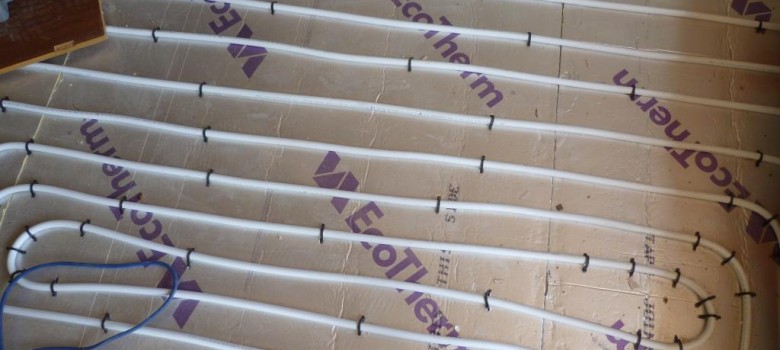
When we go out to do our Green Deal Assessments, we encounter some interesting properties on our travels. One property we recently Green Deal assessed, located in London, was going through a major refurbishment, including the installation of underfloor heating.
Underfloor heating if you have never tried it, is a real luxury; the ability to walk on a nice warm floor even in the midst of winter is definitely a most pleasurable experience! In addition, provided you have a well-insulated property; it can be a much more efficient way of heating your property compared to using radiators. This is because the temperature the floor is heated to is much lower than trying to heat with radiators, hence less energy is required and when heat rises a more even distribution of heat is achieved.
Now, the property in question was a 1975 town house in West Kensington, with cavity walls and solid floors throughout. Retrofitting underfloor heating and insulation on solid floors involves a different process than if you are looking to do the same with a suspended timber floor so please bear that in mind as you read this guide. The process for installing underfloor heating and insulation on a suspended timber floor can be found here.
Process of installing underfloor heating on a Solid Floor
In the following guide we look at installing a wet underfloor heating system, although you can install electric ‘dry’ systems.
Installing the insulation
1. Prior to laying the anything on the solid floor, you first need to insulate the envelope of the house (loft, walls and floors). This is an absolute must before starting the installing of the underfloor heating system. As mentioned they work at lower temperatures than conventional heating systems so it is imperative the heat the produce doesn’t escape, so we strongly recommend doing the insulation first, otherwise your new heating solution could essentially not work.
The first photos shows a roll of water proof membrane, which is laid out on the concrete floor. This acts as a vapour barrier that will also prevent damp from rising in the floor.
2. Having put this in place you can then install polystyrene boards like Celotex or Kingspan of variable thickness. The precise thickness of boards installed can vary from 25mm of insulation to 150mm of insulation. However on concrete floors the more insulation you put in, the more room height you sacrifice, although obviously the less heat will escape into the ground. It is vital that you don’t run the underfloor heating coils directly onto the concrete floor without first laying insulation otherwise the majority of the heat will be lost into the ground.
In the photo below I made out the thickness to be 75mm, which was added throughout the ground floor area.
3. The next step is to install the heating pipes, which are then fixed to the top of the insulation boards as shown on the photo below. These underfloor coils need to be aligned close enough together to ensure there are no cold spots under the floor.
4. This is then followed by a layer of screed (made of a combination of cement and sand), which is placed over the pipework to protect the pipes from collapsing when people stand or furniture is laid on the floor. To provide adequate protection and to ensure the floor isn’t too hot, the coils have to be buried within 65mm of screed.
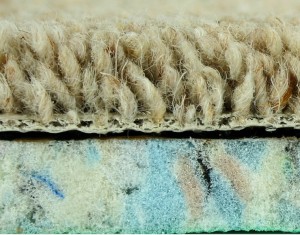 5. A range of floor finishes can be applied to the screed layer including tiles, veneer or wooden boards. This entirely depends on your taste and preference. In my property example the home owner went for a carpeted finish, which meant carpet underlay went in before the carpet was rolled out.
5. A range of floor finishes can be applied to the screed layer including tiles, veneer or wooden boards. This entirely depends on your taste and preference. In my property example the home owner went for a carpeted finish, which meant carpet underlay went in before the carpet was rolled out.
Underfloor heating with Renewables
It is also worth mentioning that underfloor heating works especially well with renewable heating solutions like air source heat pumps or solar thermal since they produce hot water at lower temperatures than traditional gas fired central heating systems. In addition since they are producing hot water at minimum cost once they have been installed they really do make the running of the underfloor heating system very economical.
If you have had a heat pump or solar thermal installed in the last couple of years give us a ring to see if you could benefit from the Renewable Heat Premium Payment which is a cashback incentive to help fund the installation of renewable heating solutions. Call us on 0208 144 0897 or send us an email to Mailbox@TheGreenAge.co.uk
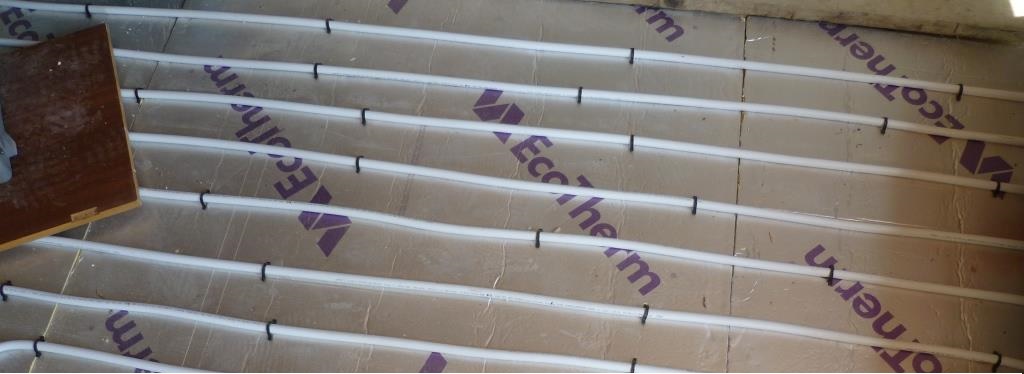
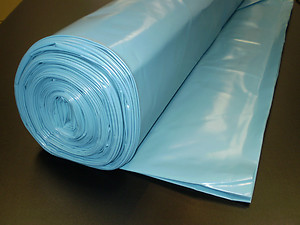
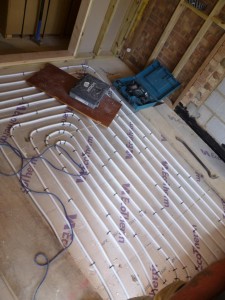












Love your website!
Hello, I want to know how well underground heating would work with a finished polished concrete floor? I was told the concrete could crack in time, do you know anything about this? And also would it be as effective heat wise using concrete as to using liquid screed?
I would like to know what the minimum the thickness should be for a polished concrete floor? Can any one advise?
Hi,as someone new to renewable energy,your web site has been very helpful and easy to follow,thank you.
Thanks Brian, that is what we like to hear!
hi – my understanding is that in old properties you should not use this method as it will cause the moisture under the DPM to be drawn into the walls and not allow the floor underneath – often earth – to breathe. Can you suggest any suitable methods that avoid this problem? Many thanks
I think your analysis is quite correct. Underfloor heating was developed for use with heat pumps in new-build properties. The companies now see a potential profit in selling it as a retrofit product for older homes. This cannot be done effectively and can be detrimental to the property, just as you say. You must also take into account the loss of at least 4 inches in the floor to ceiling height of the room. The only way to do it would be to dig out the existing floor: concrete, earth and all and to install a new one. However the very action of digging our the floor could well damage the, often shallow, foundations to the walls.
Hi, we built a new house 7 years ago and have underfloor heating downstairs. Thinking it was the children and dirty shoes we noticed the odd dirty patch over the years. This has become more widespread over the last year and it is not dirt we realised but damp! We are too late to go back to the builder and we got somebody in who advised us that as the system wasn’t losing pressure there were no leaks but what we want to know is although the floor underneath the carpets feels dry the carpets are damp in patches! Any advise would be gratefully appreciated.
Very interesting post, good job and thanks for sharing such a nice information about Installing Underfloor Heating with Solid Floors.
Hi can you let me kniw how DEEP a layer of sand should be beneath the celatex insulation before layjng underfloor heating pipes?
Hi
Can u recommend underfloor heating fitters for plymouth area
On concrete floors
There are a lot of scrap dealers in Istanbul that cut scrap with oxygen. However, there are almost no Istanbul scrap dealers who comply with the principle of occupational safety. Our scrap dealers who cut scrap iron are insured. In addition to the insured scrap cutting personnel, all of our Istanbul scrap dealer teams received training on scrap cutting.
Good article. I’m dealing with a few of these issues as well..